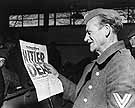
|
|
|

|

|

|

|
|
Click on an image to see a larger, more detailed picture.
|
|
|
|
|
| 1945: Liberation and Rebuilding |

|
pg. 611 |

|
|
|
|
| |
 This handwritten document, entitled Mein Testament (My Testament), spelled out Adolf Hitler's last wishes. Hitler actually composed two documents. One was a political testament naming Admiral Karl Dönitz as his successor and dismissing "traitors" such as Heinrich Himmler and Hermann Göring from the Party. The other was a personal will, stipulating that mementos were to go to his loyal secretaries. He verbally ordered that his and Eva's bodies were to be burned so that the Soviets would have no remains over which to gloat.
This handwritten document, entitled Mein Testament (My Testament), spelled out Adolf Hitler's last wishes. Hitler actually composed two documents. One was a political testament naming Admiral Karl Dönitz as his successor and dismissing "traitors" such as Heinrich Himmler and Hermann Göring from the Party. The other was a personal will, stipulating that mementos were to go to his loyal secretaries. He verbally ordered that his and Eva's bodies were to be burned so that the Soviets would have no remains over which to gloat.
Photo: Ullstein Bilderdienst
|
 Hitler's faithful subordinates, including his driver, Erich Kempka, and the commander of the SS guards, Hans Rattenhuber, followed the last order of the Führer: They took his body and that of Eva Braun to the courtyard above the bunker, doused both with gasoline, and set them aflame. Debate would swirl afterward over whether or not the remains the Soviets found and placed in this casket were in fact those of Adolf Hitler.
Hitler's faithful subordinates, including his driver, Erich Kempka, and the commander of the SS guards, Hans Rattenhuber, followed the last order of the Führer: They took his body and that of Eva Braun to the courtyard above the bunker, doused both with gasoline, and set them aflame. Debate would swirl afterward over whether or not the remains the Soviets found and placed in this casket were in fact those of Adolf Hitler.
Photo: Suddeutscher Verlag Bilderdienst
|
 Hitler's Last Days
Hitler's Last Days
The collapse of the German war effort and the steady advance of the Allied armies drove major agencies of the Nazi government into a subterranean network of underground bunkers. Adolf Hitler spent the final weeks of his life in a dank, 18-room bunker located directly under the Reich Chancellery in Berlin. As the Red Army closed in, the Führer was a shadow of his former self. His body was stooped and emaciated, and he could not prevent his hands and voice from shaking. He suffered violent mood swings and forcefully rejected an opportunity to escape Berlin by plane. Before Hitler's demise, he expelled Hermann Göring and Heinrich Himmler from the Nazi Party. He married his longtime mistress, Eva Braun, and dictated his last will and testament. The final sentence of his political testament reads: "Above all, I obligate the leaders of the nation and their following to a strict observance of the racial laws, and to a merciless resistance to the poisoner of all peoples, international Jewry." On April 30, 1945, sometime between 3:00 and 4:00 p.m., Hitler put a pistol to his head, bit into a cyanide capsule, and shot himself. Braun, too, committed suicide. The German POW seen below apparently felt little sorrow.
Photo: Bilderdienst SYddeutscher Verlag
|
|

|

|

|

|
 April 25, 1945: At Cuneo, Italy, the Gestapo arrests and murders six Jews.
April 25, 1945: At Cuneo, Italy, the Gestapo arrests and murders six Jews.
|
 April 26, 1945: The Red Army captures Brno, Czechoslovakia, freeing Oskar Schindler's Jews.
April 26, 1945: The Red Army captures Brno, Czechoslovakia, freeing Oskar Schindler's Jews.
|
 April 26-May 3, 1945: Survivors of the concentration camp at Stutthof, Poland, are evacuated by sea to Lübeck, Germany, a journey of more than 300 miles. Hundreds perish during the seven-day voyage.
April 26-May 3, 1945: Survivors of the concentration camp at Stutthof, Poland, are evacuated by sea to Lübeck, Germany, a journey of more than 300 miles. Hundreds perish during the seven-day voyage.
|
 April 27, 1945: Of 2775 death-marchers moving east from Rehmsdorf, Germany (near Buchenwald), 1000 are killed by grenades and machine-gun fire from SS guards at Marienbad, Czechoslovakia, for attempting to flee. Twelve hundred more will be killed on the march and another 500 will be murdered after arriving at Theresienstadt, Czechoslovakia. Of the 2775 marchers, just 75 will survive.
April 27, 1945: Of 2775 death-marchers moving east from Rehmsdorf, Germany (near Buchenwald), 1000 are killed by grenades and machine-gun fire from SS guards at Marienbad, Czechoslovakia, for attempting to flee. Twelve hundred more will be killed on the march and another 500 will be murdered after arriving at Theresienstadt, Czechoslovakia. Of the 2775 marchers, just 75 will survive.
|
 April 27, 1945: The concentration camp at Sachsenhausen, Germany, is liberated by the Red Army; 3000 inmates remain alive.
April 27, 1945: The concentration camp at Sachsenhausen, Germany, is liberated by the Red Army; 3000 inmates remain alive.
|
 April 27, 1945: The camp at Kaufering, Germany, is liberated by the U.S. Army. Very few inmates remain alive.
April 27, 1945: The camp at Kaufering, Germany, is liberated by the U.S. Army. Very few inmates remain alive.
|
|
|
|
|
| 1945: Liberation and Rebuilding |

|
pg. 611 |

|
|
The Holocaust Chronicle
© 2009 Publications International, Ltd.
|
|
